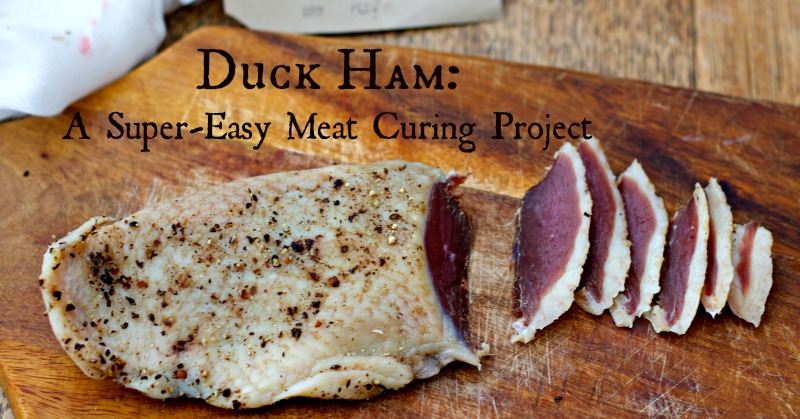I have a new curing project for you, and I’m excited because it’s so easy! Duck Ham. There’s no heat involved in this one, just an overnight cure and then air-drying– and this duck ham only takes a week from start to finish! So if you would like to try making your own cured meats at home but are feeling a little intimidated, this is a great one for you to get started with. This is another project that I am sharing from one of my favorite books, Food DIY. According to Tim Hayward, this is a prosciutto- style cure, and these smaller pieces of duck (you can also use rabbit) yield safe and beautiful results. Let’s get started!
Making Duck Ham
What You’ll Need
- 2 tsp (10g) fresh or dried thyme, rosemary or juniper (I used thyme)
- 1 tsp (5g) freshly cracked black pepper
- 1 1/4 cup (200g) coarse sea salt
- 1 duck breast
- butcher’s string
- cheesecloth or muslin cloth
- recommended: a kitchen scale, like this one
What to Do
1. Mix the salt and the herbs together to form the curing mixture.
2. Coat the duck breast with the curing mixture, add the rest to a ziplock freezer bag or a class container, and put the duck breast in. If you’re using a bag, then press out all the air when sealing. Let sit for 24 hours. [Note: next time I do it, I will remove the skin with a sharp knife first, leaving as much of the layer of fat beneath intact. This is what I recommend you do, too.]

3. Wash the cure mixture off of the duck breast, pat it dry with a clean kitchen towel, and grind some fresh black pepper onto it, pressing it in a little. You will notice that the little slab of meat is now much more dense and kind of stiff– this is from the dehydration caused by the curing salts drawing out the moisture from the duck breast.
 4. Wrap it up in muslin, and tie with butcher’s string. The instructions in Food DIY said to “tie it tightly in several places,” but I really didn’t see the point in that, figuring it would dry out better as it was, plus it’s already very, very flat.
4. Wrap it up in muslin, and tie with butcher’s string. The instructions in Food DIY said to “tie it tightly in several places,” but I really didn’t see the point in that, figuring it would dry out better as it was, plus it’s already very, very flat.
5. Hang in a cool airy place for a week. I used my conservatory, which stays pretty cold at this time of year. The instructions I was using didn’t say a whole lot about optimal temperatures, but I know that if you want to be very careful, you can hang it in your fridge, where the temperatures do not rise above 40F or 4C. Air circulation is important. In most other air-dried curing projects, it’s recommended that you weigh the meat when you take it out of the curing mixture, and then weigh it every few days as you let it hang, and eat it when it has achieved a 30% weight loss. This recipe doesn’t ask you to do any of that, and I gave it an extra day and a half, just to be sure. I’d like to note that there was no mold or bloom growing on the duck ham at all, and it always had a pleasant, hammy scent through the week.
 6. Slice thinly and serve. It tastes great– clean but nice and duck-y. And the color is really lovely, too. If I do anything different next time, it will be to add more thyme, as the flavor didn’t come out quite a strongly as I would have liked. I think I’ll experiment next time with adding some sugar to the cure, too. It’s salty, so do slice it very thinly.
6. Slice thinly and serve. It tastes great– clean but nice and duck-y. And the color is really lovely, too. If I do anything different next time, it will be to add more thyme, as the flavor didn’t come out quite a strongly as I would have liked. I think I’ll experiment next time with adding some sugar to the cure, too. It’s salty, so do slice it very thinly.
 This project of making duck ham was my first time curing a meat without smoking it, and it was so easy! I highly recommend it, if you are wanting to do a small curing project that won’t take much time or meat.
This project of making duck ham was my first time curing a meat without smoking it, and it was so easy! I highly recommend it, if you are wanting to do a small curing project that won’t take much time or meat.
Did you like this post? Share it and pin it for later!




Wonderful! I must try this! I had this, or something very much like it, years ago in a fascinating little restaurant (basically someone’s house) in the Dordogne years ago, it was delicious. This was also the evening I got to try adder’s venom in alcohol (there was a dead snake in the bottle). Don’t think you’d get away with that sort of thing in England 😉
Well, that sounds like a pretty memorable dinner! Awesome. I do hope you’ll try it– it’s so easy, and very good.
I tried it last week and it was delicious:3 but i was wondering how long can you keep it?
Do you eat it raw then, or cook it like bacon?
Yes Laurel, it’s eaten raw just like prosciutto, jamón serrano, etc.
If you don’t want it so salty, rinse it after coming out of the cure. I made this using rabbit and it came out great. I did add another tbl of sugar to the spice mix. Thanks for another fantastic ham recipe to add to my list.
Oh my yum! Sending this to my husband with the hopes he will try this out.
Keeping my fingers crossed for you! 😉
If I add time dose it add flavor like other meat’s
Hi Donald,
If you are talking about the herb thyme, then yes, it will add flavor to the meat.
sounds awesome… does it just sit out on the counter for the initial 24 hours ?
and how long do you reckon it will last in the fridge after curing ?
cheers !!!
Hi Kevin, it goes in the fridge while it’s curing for the 24 hours. And I have read that it can be stored for months in the fridge (although it will continue to dry out.)
dynomite !
thanx !!!
I am SUPER excited to try this out! Thanks for the great idea!
How exciting! I want to try this with rabbit now and of course the duck sounds delicious too 🙂
This recipe looks delicious AND it fits the paleo autoimmune protocol (a rare thing). So, thank you! I recently started a weekly Paleo AIP Recipe Roundtable through my blog, and I would love it if you linked up this recipe. I’m trying to expand resources for the AIP community. Here’s the link: https://www.phoenixhelix.com/2014/01/22/paleo-aip-recipe-roundtable-11/
Oh my gosh this is awesome! I never even considered curing duck breasts. I can’t wait to try this, thanks!
I have been very interested in doing this for years! I am excited to find you! Are there any other meats that I could use for this process? We have our own grass fed beef. What cut would you recommend, if so? What about a turkey breast? Thank you!
I have cured beef eye fillet, sooooo good! Can’t wait to try the duck breast, just in time for christmas!!!!
Very cool.
Just so you know, this is NOT a duck ham!
https://ducksonly.com/images/FarmPig16_941_200.jpg
???
Thinking of trying this with a wild turkey breast. I’ve corned venison to where it tasted like corned beef with great success.
Used a (Canada) goose breast I had in the freezer, skinless, no fat. It was delicious…a surprise star on the appetizer table amongst my foodie friends and family, where it was dubbed prosciutto. The goose breast was the perfect size. I think wild duck breasts might be too small, I.e., too salty after the cure.
This did come out really salty, so I think goose breast is a great idea. So glad everyone loved yours– thanks for reporting back!
This is exactly like biltong (usually beef, but all sorts of game are used too, and ostrich).
Can I use fine sea salt? I don’t have coarse on hand. >_<
Rose, it will come out WAY too salty with fine salt. I would definitely wait until I could get coarse salt.
I know I’m late to the game, but if you can find Koshering salt, that works perfectly. I’ve been doing this for nearly 20 years now, but I hang it for three weeks, just to be sure.
Just out of interest – did you take a note of how much weight was lost during the week or so that it was hanging?
Hi. LOVE your Blog. This sounds like a great first meat curing project. Have you done this more than once? Any updates you’d give? Goose Ya? HM going to have to look for that here. Thanks!
I did four fresh duck breasts and I used a salt, brown sugar, 8 chopped garlic cloves and chili flakes and a lot of fresh time. The end result was spectacular. It’s important to experiment with ingredients you like. I use this mix when curing for Duck confirm also.
Should read duck confit.
I love duck…any style. I usually buy the whole oil preserved duck from Chinatown. Your presentation of this duck ham method make my mouth watery.
Hi I am very interested to try this with Canadian goose breast, as an experiment, however they don’t have the fat layer found on reared / tame ducks so I am tempted to remove the skin altogether as it’s got a bitter taste when cooked in pan and oven and I assume this will also happen when cured ? Any feedback on this subject would be appreciated.
Big John Northampton, UK
I don’t have a way to safely air dry it in the way of hanging it. Could it be wrapped and stored in Tupperware in fridge if drained often?
Hi Josh,
I really can’t recommend trying to do it in the fridge. You need free air circulation around the duck breast. You could do a little googling about using your oven (many people do jerky/biltong that way) but I really don’t have any experience with that.
I followed the receipt to the T and my duck breast came out SUPER Salty. Almost not edible, did I miss something along the way. I used course sea salt and Thyme for the cure.
I used two packages of Morton Course Sea Salt.
It’s very important to thoroughly scrub off the curing salt. I was lazy about that once, and it came out way too salty.
I hung my duck breasts on a hook in the refrigerator for a week, and it turned out perfectly.
I used one of those stick on hooks, attached it to the top of the refrigerator. Perfect!
I am getting ready to cure another couple of breasts this weekend. LOVE this recipe.